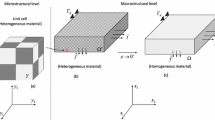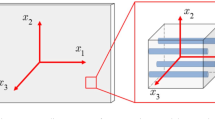Abstract
In this investigation, a re-formulation has been developed to investigate the effect of fiber aspect ratio on the effective elastic moduli of fiber-reinforced polymers/composites. The matrix and inclusions are considered as isotropic materials. The five independent elastic constants are derived based on a modified Mori–Tanaka theory. The relationship between composite elastic constants and inclusion aspect ratio is also established. Three types of composites containing unidirectional aligned fiber and two-dimensional and three-dimensional random orientated inclusions are explicitly analyzed. Moreover, three extreme cases involving long fibers, spheres, and thin discs are taken into account. It is found that the longitudinal elastic properties are very sensitive to fiber-like inclusions, whereas the transverse elastic properties are closely related to disc-like inclusions.

















Similar content being viewed by others
References
Rodríguez-Ramos R, Guinovart-Díaz R, Bravo-Castillero J, Sabina FJ, Berger H, Kari S, Gabbert U (2009) Variational bounds for anisotropic elastic multiphase composites with different shapes of inclusions. Arch Appl Mech 79(8):695–708
Wang J, Pyrz R (2004) Prediction of the overall moduli of layered silicate-reinforced nanocomposites—part I: basic theory and formulas. Compos Sci Technol 64(7):925–934
Pan J, Bian LC (2017) Influence of agglomeration parameters on carbon nanotube composites. Acta Mech 228(6):2207–2217
Pan J, Bian LC, Zhao HC et al (2016) A new micromechanics model and effective elastic modulus of nanotube reinforced composites. Comput Mater Sci 113:21–26
Lee KY, Paul DR (2005) A model for composites containing three-dimensional ellipsoidal inclusions. Polymer 46(21):9064–9080
Kashtalyan M, Sinchuk Y, Piat R, Guz I (2016) Analysis of multiple cracking in metal/ceramic composites with lamellar microstructure. Arch Appl Mech 86(1–2):177–188
Kordkheili SAH, Toozandehjani H (2014) Effective mechanical properties of unidirectional composites in the presence of imperfect interface. Arch Appl Mech 84(6):807–819
Lee JK, Kim JG (2013) Model for predicting effective thermal conductivity of composites with aligned continuous fibers of graded conductivity. Arch Appl Mech 83(11):1569–1575
Zhao YH, Tandon GP, Weng GJ (1989) Elastic moduli for a class of porous materials. Acta Mech 76(1–2):105–130
Mori T, Tanaka K (1973) Average stress in matrix and average elastic energy of materials with misfitting inclusions. Acta Metall 21(5):571–574
Benveniste Y (1987) A new approach to the application of Mori-Tanaka's theory in composite materials. Mech Mater 6(2):147–157
Walpole LJ (1981) Elastic behavior of composite materials: theoretical foundations. Adv Appl Mech 21:169–242
Choi MO, Kim YJ (2018) Effect of poly (3-hydroxybutyrate-co-3-hydroxyvalerate) /gelatin ratios on the characteristics of biomimetic composite nanofibrous scaffolds. Colloid Polym Sci 296(5):917–926
Panda S, Reddy NH, Kumar ASP (2015) Design and finite element analysis of a short piezoelectric fiber-reinforced composite actuator. Arch Appl Mech 85(5):691–711
Bian LC, Zhao HC (2015) Elastic properties of a single-walled carbon nanotube under a thermal environment. Compos Struct 121:337–343
Sindu BS, Sasmal S (2015) Evaluation of mechanical characteristics of nano modified epoxy based polymers using molecular dynamics. Comput Mater Sci 96:146–158
Hill R (1965) A self-consistent mechanics of composite materials. J Mech Phys Solids 13(4):213–222
Chang CI, Conway HD, Weaver TC (1972) The elastic constants and bond stresses for a three-dimensional composite reinforced by discontinuous fibers. Fibre Sci Technol 5(2):143–162
Russel WB (1973) On the effective moduli of composite materials: effect of fiber length and geometry at dilute concentrations. Zeitschrift Für Angewandte Mathematik Und Physik Zamp 24(4):581–600
Tandon GP, Weng GJ (1986) Average stress in the matrix and effective moduli of randomly oriented composites. Compos Sci Technol 27(2):111–132
Jarali CS, Patil SF, Pilli SC, Lu YC (2013) Modeling the effective elastic properties of nanocomposites with circular straight CNT fibers reinforced in the epoxy matrix. J Mater Sci 48(8):3160–3172
Tian W, Qi L, Zhou J, Guan J (2014) Effects of the fiber orientation and fiber aspect ratio on the tensile strength of C sf/Mg composites. Comput Mater Sci 89(12):6–11
Halpin JC, Tsai SW (1967) Environmental factors in composite materials design. Air force technical. Report:67–423
Thomason JL (2008) The influence of fibre length, diameter and concentration on the modulus of glass-fibre reinforced polyamide 6, 6. Compos A Appl Sci Manuf 39(11):1732–1738
Tucker Iii CL, Liang E (1999) Stiffness predictions for unidirectional short-fiber composites: review and evaluation. Compos Sci Technol 59(5):655–671
Ferrari M, Johnson GC (1989) The effective elasticities of short-fiber composites with arbitrary orientation distribution. Mech Mater 8:67–73
Chen CH, Cheng CH (1996) Effective elastic moduli of misoriented short-fiber composites. Int J Solids Struct 33:2519–2539
Böhm HJ (2004) Modeling the mechanical behavior of short fiber reinforced composites, in “Mechanics of Microstructured Materials” (Ed. H.J.Böhm). Springer–Verlag, Vienna 41–56
Giordano S (2005) Order and disorder in heterogeneous material microstructure: electric and elastic characterisation of dispersions of pseudo-oriented spheroids. Int J Eng Sci 43:1033–1058
Marzari N, Ferrari M (1992) Textural and micromorphological effects on the overall elastic response of macroscopically anisotropic composites. J Appl Mech 59:269–275
Berryman JG, Berge PA (1996) Critique of two explicit schemes for estimating elastic properties of multiphase composites. Mech Mater 22:149–164
Allen DH, Lee JW (1990) The effective thermoelastic properties of whisker-reinforced composites as functions of material forming parameters. In: Weng GJ, Taya M, Abé H (eds) Micromechanics and Inhomogeneity. Springer-Verlag, New York, pp 17–40
Pettermann HE, Böhm HJ, Rammerstorfer FG (1997) Some direction dependent properties of matrix–inclusion type composites with given reinforcement orientation distributions. Composites B 28:253–265
Mlekusch B (1999) Thermoelastic properties of short-fibre-reinforced thermoplastics. Compos Sci Technol 59:911–923
Hong GK, Kwac LK (2009) Evaluation of elastic modulus for unidirectionally aligned short fiber composites. J Mech Sci Technol 23(1):54–63
Richard TG (1975) The mechanical behavior of a solid microsphere filled composite. J Compos Mater 9(2):108–113
Norris AN (1990) The mechanical properties of platelet reinforced composites. Int J Solids Struct 26(5):663–674
Pettermann HE, Böhm HJ, Alcalá J (2002) Normalized diagrams for micromechanical estimates of the elastic response of composite materials. Metall Mater Trans A 33(10):3187–3199
Funding
This study was funded by the Science Research Foundation of Hebei Advanced Institutes (ZD2017075) and Graduate Innovation Research Assistant Support Project of Yanshan University (CXZS201708).
Author information
Authors and Affiliations
Corresponding author
Ethics declarations
Conflict of interest
The authors declare that they have no conflicts of interest.
Additional information
Publisher’s note
Springer Nature remains neutral with regard to jurisdictional claims in published maps and institutional affiliations.
Appendix
Appendix
For a spherical inclusion with a1 = a2 = a3 and fiber aspect ratio λ = 1, the components of the tensor S are simplified to
For a long fiber-shaped inclusion with aspect ratio \( \lambda =\frac{a_1}{a_3}\to \infty \), we have
For a thin disc with \( \lambda =\frac{a_1}{a_3}\to 0 \), we get
For the spheroidal inclusion \( \lambda =\frac{a_1}{a_3} \), the components of the tensor S are simplified to
where ν0 is the Poisson ratio of the matrix, λ is the aspect ratio of the inclusion, and g is given by
\( g=\frac{\lambda }{{\left(1-{\lambda}^2\right)}^{3/2}}\left[\operatorname{arccos}\left(\lambda \right)-\lambda {\left(1-{\lambda}^2\right)}^{1/2}\right] \), prolate shape a1 > a2 = a3.
\( \mathrm{g}=\frac{\lambda }{{\left({\lambda}^2-1\right)}^{3/2}}\left[\lambda {\left({\lambda}^2-1\right)}^{1/2}-\operatorname{arccos}h\left(\lambda \right)\right] \), oblate shapea1 < a2 = a3.
Rights and permissions
About this article
Cite this article
Pan, J., Bian, L. A re-formulation of the Mori–Tanaka method for predicting material properties of fiber-reinforced polymers/composites. Colloid Polym Sci 297, 529–543 (2019). https://doi.org/10.1007/s00396-019-04472-y
Received:
Revised:
Accepted:
Published:
Issue Date:
DOI: https://doi.org/10.1007/s00396-019-04472-y




